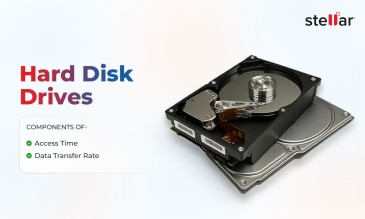What Are Helium-Filled Hard Drives? An Overview
Helium-filled hard drives are a new family of hard disk drives, first launched by Hitachi Global Storage Technologies in 2013. These helium-filled HDDs are fundamentally magnetic storage devices, like the traditional hard disk drives, with a spinning
platter, actuator arm, read/write head assembly, etc.
However, they are filled with helium gas instead of air and hermetically sealed to stop the gas from escaping the drive casing. Therefore, the design and manufacturing of helium-filled hard disk drives is incredibly complex, with intricate
calibration and mechanisms to make them work. As a result, any situation that leads to the physical failure of helium-filled HDDs is remarkably challenging from the data recovery standpoint. A class 100 cleanroom lab and demonstrable expertise
in invasive hard drive recovery techniques are minimum requirements.
Helium-Filled Drives vs Traditional HDDs: Comparison
Traditional hard disk drives, by design, use air as the virtual bearing to cushion the intricate floating movement of read/write heads over the platter. Without a carefully sustained air pressure, equalized through a breather orifice in the drive chassis, the head will tend to crash into the platter resulting in drive failure.
This air, though necessary for the drive’s functioning, exerts a significant drag on the spinning disks, lowering the drive’s read/write speed and increasing its energy consumption.
Using helium instead of air dramatically alleviates this
problem because helium has about one-seventh the density of air, resulting in reduced drag. Thus, the disks inside a helium-filled HDD can spin much faster than standard HDDs while consuming less energy.
According to an industry estimate, helium-filled hard drives are up to 20% more energy efficient than traditional HDDs and have higher sequential read/write speed due to the reduced drag.
Further, the sparsity of helium allows manufacturing a more compact hard drive design, typically with up to 1-inch height, with thinner platters in higher numbers. As a result, helium-filled hard drives can have significantly higher storage capacity than traditional HDDs. For example, Western Digital® could use eight platters to attain 12 TB capacity in a single helium-filled drive called the Ultrastar He12. However, this design further adds to the complexity of helium-filled drives as more disks need to spin in a compact space.
Helium-Filled HDDs: Hermetic Sealing Poses a Key Challenge to Data Recovery
A key manufacturing challenge of helium-filled drives is to seal the gas inside the casing and avoid it from escaping. This task is technically strenuous considering helium’s low density and compactness of such drives. Another challenge is to avoid the atmospheric air from entering the casing due to natural diffusion. And, therefore, helium-filled HDDs are hermetically sealed using an incredibly complex technology based on laser welding, performed on a silicon-rich alloy casing by using the laser at a specific angle.
Imagine, a hermetically sealed HDD fails due to a crashed head assembly or bad sectors. How would you recover the data from the drive? The process would necessitate physical operation on the HDD in an environment that mimics the OEM facility where the drive was manufactured.
Further, this lab facility would ideally need to have a helium-filled enclosure maintained as per Class 100 Clean Room specifications to allow safe recovery procedures on the hard drive.
Data Recovery from Failed Helium-Filled Drives: General Procedure
The following section outlines the general lab procedure and steps for data recovery from helium-filled hard disk drives:
1. Hard Drive Diagnosis
In this step, the HDD is checked for clicking, whirring, beeping, or grinding sounds to understand the underlying problems. These sounds are typical indicators of a physically failing or failed hard drive.
2. Lab Diagnosis
The hermetically sealed hard drive casing is opened in a Class 100 Clean Room lab to visually inspect components, such as platter, head assembly, and actuator. Class 100 lab is crucial to allow safe operations by providing an atmosphere free of contaminants, moisture, and submicron particulates that can scratch the drive platter.
3. Replacement of Head Assembly
Hard drives, including helium-filled HDDs, generally fail due to a broken or crashed head assembly. This step involves transplanting a replacement head assembly to restore the drive to its normal functioning state. After transplanting the head assembly, the drive is sealed back in the casing.
4. Drive Cloning
The next step after head assembly replacement is drive cloning, wherein the restored HDD is cloned on a new helium-filled hard drive to allow further data recovery procedures without the chances of mid-process failures.
5. Data Recovery
Data recovery software is run on the cloned hard disk drive to recover the data.
Ending Notes
Helium-filled drives represent a bleeding-edge technology that is unfolding and may take a few years to go mainstream in terms of adoption, design simplification, support ecosystem, etc. Due to their complex make and design, helium HDDs pose immense difficulties in failure scenarios. It looks impossible to restore a physically failed or crashed helium drive to its original state due to hermetic sealing, done using state-of-the-art techniques. But, even data recovery from such failed drives requires unsurpassed expertise, infrastructure, and experience. Considering these facts, we advise you to rely only upon professional data recovery services after vetting them through rigorous evaluation. Be aware that you get only one chance to pull off successful recovery from physically crashed drives. So, practice discretion and diligence when trusting a data recovery service.
Imagine, a hermetically sealed HDD fails due to a crashed head assembly or bad sectors. How would you recover the data from the drive? The process would necessitate physical operation on the HDD in an environment that mimics the OEM facility where the drive was manufactured.
Further, this lab facility would ideally need to have a helium-filled enclosure maintained as per Class 100 Clean Room specifications to allow safe recovery procedures on the hard drive.
About The Author

Sr. Online Marketing Executive and Content Writer at Stellar Data Recovery.












